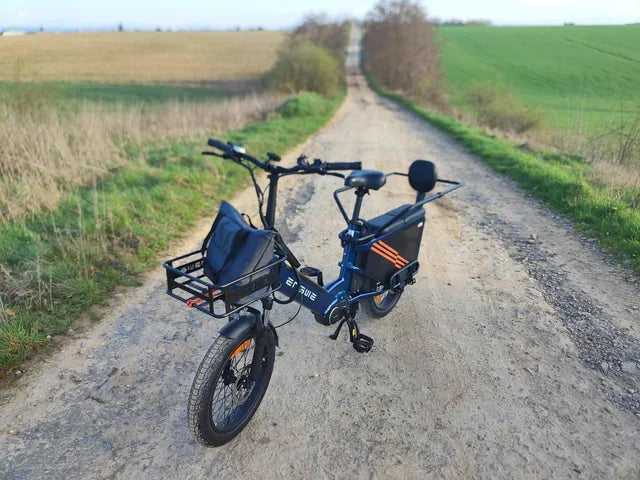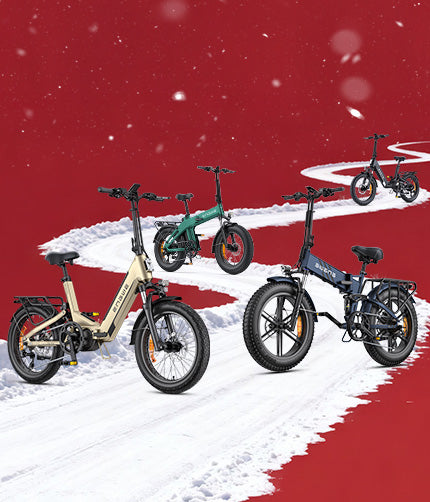Core Mechanism and User Experience: Pedal Assist vs. Throttle
The first thing you need to know when choosing an electric bike is this component: pedal assist or throttle. They determine how the engine's power will be supplied to you and shape the difference in how you ride. And while one way or another, they all make you feel like it’s easier to ride a bike, they do so from a different perspective and background. So, with this guide, we break down the five most critical differences. Finally, you will know which system is right for you, what combination of them will suit you best, and you will also discover a simple concept for cycling.
The first and most basic is the core mechanism and resulting user experience. The motor is told to engage via pedal assist or throttle, and how it's told to do so completely changes how it feels to ride the bike. In a PAS system, you must be actively pedaling for the motor to kick in. It creates a cooperation between rider and machine that impacts how every ride feels. Conversely, a twist throttle, like on a motorbike or scooter, sends power to the wheel regardless of pedaling. Knowing this first distinction is the entrance to determining which e-bike is right for you.
PAS (Pedal Assist System)
This system uses a pair of pedals (and a sensor to detect when the pedals are being used) to work. There are two types of sensors. A basic cadence sensor tells the motor to engage once the pedals start moving. In contrast, a more advanced torque sensor calculates the proper power output based on how hard you are pedaling. It feels like you are biking but with a much stronger output.
Throttle
When you wish to accelerate, this device on the handlebar is twisted. As soon as you engage it, it sends a signal to the motor to power the wheel directly. You decide how "fast" you want the motor to go, from a standstill to full power, without the need to pedal. PAS is a more active way to ride, as you are still contributing to forward progress, while a throttle offers a less engaging control configuration.
Personal Goals: Fitness, Utility, and Accessibility
Your choice between pedal assist and throttle will also heavily depend on your personal goals, likely related to fitness and health, and which component you consider the central part of your ride. While they can be used in conjunction, the two systems are designed for very different purposes. Pedal assist relies on your active lifestyle – any hill or distance becomes a workout, which may be an intimidating idea for some. The throttle system works perfectly for long distances and has a unique number of advantages for those riding for utility or those who have physical restrictions, meaning it makes cycling a viable option for a broader population instead of excluding people.
Exercise
Pedal assist wins, as activating the motor relies on your pedaling, which means that you will be exercising either way. One might choose a lower level of assistance to work harder or increase it to keep up with faster riders or tackle difficult terrain while still keeping the heart rate high.
Commuting and Utility
The throttle is a guarantee of successful commuting, as it enables the user to not wobble when starting from a standstill at a red light and maintain speed without sweating, ensuring that you arrive at your destination fresh.
Accessibility and Recovery
For people with knee issues, someone recovering from an injury, or various restrictions, the throttle is an instant game-changer, as it eliminates the main barrier to entry regarding physical effort.
Enjoyment Options
Many e-bikes employ both systems, meaning the user can enjoy a long, relaxing exercise on a scenic trail while pedaling and then have a relaxed ride home with little to no effort.

Battery Range, Efficiency, and Maintenance
A critical and practical aspect is the implications for battery range, general efficiency, and maintenance issues down the line. Your power consumption from the battery directly impacts battery range and the expected lifespan of individual components on a single charge. While throttles are infamous for being 'hungrier,' pedal assistance systems, especially the ones with proper, reliable sensors, are much more efficient in this regard. The correct choice here can potentially save you a considerable amount of money on battery replacement and give you a chance at running a single electric bike for years.
Benefits
Throttle consumes direct power, often at a higher rate and especially during startup acceleration, spending battery power faster. Pedal assistance is more efficient due to the combination of electric motor power and your own pedaling, resulting in a much longer range.
Expert Advice for Maximizing Battery Life
To ride the longest distance per charge, use the lowest comfortable level of pedal assist. In addition, at a standstill, we recommend everyone pedal several times before the motor kicks in, as it saves a lot of charge. On relatively flat terrain, don't forget to pedal regularly; use the throttle only to assist you up hills.
Stress on the Motor and Drivetrain
Although both systems are durable, excessive use of the throttle from a standstill, or accelerating to full speed then stopping abruptly, will wear down the motor and transmission elements.
A Key Quality Feature
As systems become more ergonomic and cost-effective, sensor performance is a primary differentiating factor. Therefore, pay attention to the motor system's sensors; choose a torque sensor over a cadence sensor if your budget allows.
Legal Regulations and Trail Access
Knowing the legal regulations and access rules is essential when choosing between systems. Essentially, the drive system, and in particular the presence or absence of a throttle, determines the bike's legal classification, which leads to different legal riding possibilities – from city bike lanes to mountain trails. Riding a throttle-equipped e-bike on restricted paths can result in a fine or having your bike impounded. So, it’s not just a question of preference; it’s about compliance and access.
E-Bike Classifications
E-bikes in the United States and other areas are often classified into one of three classes:
Class 1: Pedal-assist with a maximum speed of 20 mph.
Class 2: Throttle assist with a maximum speed of 20 mph permitted.
Class 3: Pedal-assist only (no throttle) with a maximum assisted speed of 28 mph.
For Pavement and Bike Lanes
Most Class 1 and Class 2 e-bikes are allowed wherever regular bikes are. Class 3 may be more limited, but these regulations are set by the state and city, so check locally.
For Mountain Bike and Trail Access
This is where it gets complex. Throttle-equipped e-bikes are prohibited on many natural surface trails, particularly mountain biking ones, to preserve the trail experience. Class 1, meanwhile, is generally legal. Always check the local regulations for the park or trail system before riding.
Global Variations
Regulations differ significantly by country. For instance, the EU restricts motors to 250W, and throttle-only e-bikes are forbidden on public roadways in many nations.

Choosing the Right E-Bike for You
The correct choice is still highly individual. The ENGWE L20 Boost is our leading recommendation to all riders who desire the supreme blend of effortless assistance and added reserve power in addition to substantial utility. This bicycle demonstrates the full extent to which cutting-edge designs can intelligently incorporate advanced technology for various purposes. It offers the pleasure of a regular bicycle ride with the added stability that comes from knowing extra power is available whenever you need it. This makes it one of the optimal options for many kinds of riders available today. The L20 Boost is a bicycle with a decent and better-than-average range. It is more than a one-way transportation system; the bike is a diverse asset tailored for power, contentment, and the finest mobility available.
For the Rider Who Wants Power and Intuitiveness: The ENGWE L20 Boost

The ENGWE L20 Boost is a multifaceted electric bike that is both convenient and efficient. The bike comes with an innovative torque sensor that provides an intuitive and responsive natural boost to your pedaling effort for a comfortable ride. It is distinguished by its Power-Boost switch, which unlocks the full 75 Nm of torque for climbing and quick acceleration. It feels like a premium pedal-assist system but with the burst of power of a throttle when you need it. The 126 km battery, robust 20×4.0 fat tires, and useful baskets make it a well-adapted bike for long journeys.

For the Purist Urban Commuter
If your primary focus is urban traffic, energy management, integrated lights for safety, fenders for cleanliness, and lightweight transport, this is the right path.
For the Off-Road Passionate
The primary focus should be given to choosing an e-bicycle with higher front and rear suspension, powerful hydraulic brakes, and geometry specifically built for e-mountain biking if you dream of kilometers of trails.
In essence, this table presents the distinctions between pedal-assist sensors. To further illustrate, different sensors are associated with different types of pedal-assist experiences. Here is a table to compare the types of sensors:
| Feature | Cadence Sensor | Torque Sensor |
|---|---|---|
| Activation | Detects if pedals are turning (on/off). | Measures the force of your pedaling. |
| Power Delivery | Delivers a set amount of power per assist level. | Delivers power that is dependent on your effort. |
| Riding Feel | Can feel jerky or like a sudden push. | Smooth, intuitive, and natural; it provides a sense of continuity with your power. |
| Efficiency | Less efficient since it can provide way more power than is needed. | Highly efficient; it increases battery life by only giving you the necessary power. |
Frequently Asked Questions:
Can an e-bike have both pedal-assist and a throttle?
Yes, many e-bikes, often classified as Class 2, have both. This provides maximum flexibility, enabling you to have an active ride with the PAS or a relaxing cruise with the throttle. Both systems are ideal for climbing steep hills. A powerful pedal-assist system will make you feel like you are in control while struggling to climb. A throttle can supply power to allow you to climb a hill without pedaling; this feature is a lifesaver if the rider is too tired.
Is one system safer than the other?
Pedal assist is generally considered more stable because the power delivery is linked to your pedaling. A throttle requires more careful management. The motor can engage unexpectedly if the throttle is twisted inadvertently.









